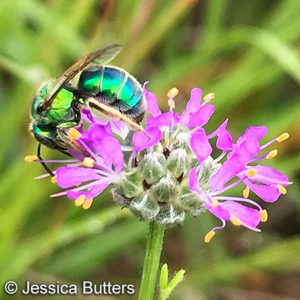June is National Pollinator Month! While many animals can act as pollinators (from bats to butterflies to beetles), this month we are choosing to celebrate the most efficient pollinators of them all: native bees!
Iowa has nearly 400 species of native bees. While the word “bee” brings the honey bee (Apis mellifera) to most people’s minds, this is just one species of bee and it is not native to Iowa; they were brought to the States by early settlers. Unlike honey bees, nearly all of Iowa’s native bees are solitary, meaning one female bee creates and tends her own nests. There are too many bee groups and species to cover in one article, and therefore we are focusing on only eight common groups of bees in Iowa to appreciate this month: bumble bees, cellophane bees, sweat bees, mining bees, mason bees, long-horned bees, leafcutter bees, and carpenter bees.
Bumble Bees
One of the most beloved groups of bees, bumble bees are large bees that look chunky and fluffy (what’s not to love?). They nest above or below ground in abandoned burrows or cavities, and are Iowa’s only truly social native bees! Their colonies can be large but only live for one year. Near the end of the hive’s life, young queens hatch and leave the hive to hibernate alone during winter, then emerge the next year to start their own hives. An easy way to tell bumble bees apart from large carpenter bees is that they have fuzzy abdomens, while carpenter bees have shiny black, nearly hairless abdomens.
Cellophane Bees
Also known as plasterer bees or polyester bees, these fuzzy friends are in the bee genus Colletes. They are known by a wide range of plastic-alluding names due to the plastic-like coating they create to line their underground nest cells. The plastic-like substance acts like waterproofing, protecting eggs and developing larvae from moisture, fungus, and other threats. Cellophane bees are active in spring here in Iowa.
Sweat Bees
Bees in the sweat bee group belong to the family Halictidae. They come in a vast array of colors, sizes, and nesting strategies; there are about 500 different species of sweat bees in North America alone! My favorite genus of sweat bee may be Augochloropsis; these bees have green, comma-shaped wing shields (also called tegulae), are a brilliant blue-green color, and there’s even a bee with the species name metallica! Other sweat bee genera range from metallic to dull brown in color, with many nesting in the ground. While not truly social, some sweat bees nest communally by sharing main tunnels underground, similar to how we share hallways in apartment buildings!
Mining Bees
This group of bees often includes bees in the Andrenidae family. These bees excavate their nests in the ground and come in a range of sizes. These bees are currently active in Iowa! Look for their nests by finding small piles of dirt around a hole the size of a #2 pencil (though the size of the hole varies between species). You may find more than one nest in an area!
Mason Bees
Belonging to the genus Osmia, this group of bees is especially important for the pollination of fruit and other crops! They are also in the same family as leafcutter bees (Megachilidae). They are beautiful metallic bees here in Iowa and are active in spring. Some species are cavity nesters, so they may occupy a bee hotel if provided! Alternately, some species make their nests entirely out of mud, a trait that earned them the nickname “mason bee”.
Long-Horned Bees
Aptly named for their long antennae, most species of long-horned bees nest in the ground. Only males have amazingly-long antennae, sometimes nearly reaching the length of their entire body! Many bee genera belong to the long-horned bee group. Some species are very fluffy and are consequently called “teddy bear” bees, which is probably the cutest nickname in the insect world!
Leafcutter Bees
Belonging to the genus Megachile (meaning “big-lipped” in Greek), many leafcutter bees have huge jaws that cut pieces of leaves with which to line their nests. These bees mostly nest above-ground and may utilize your bee hotel. While many bees store pollen on their hind legs, leafcutter bees are unique in that they collect and store pollen using the underside of their abdomen! There they have thick, broom-like hairs called scopa that sweep up and trap pollen during flower visits.
Carpenter Bees
Did you know that there are two main kinds of carpenter bees? There are the large carpenter bees that you are probably familiar with, which can look similar to bumble bees. However, there is a second, lesser-known group of tiny carpenter bees belonging to the genus Ceratina. These tiny carpenters chew down the pithy centers of stems and twigs to form rows of nest cells. These bees are one of the reasons to dead-head your flowers and leave the stems standing at the end of the growing season; you’re providing a nesting site for tiny bees! Also, some species have the coolest cream-colored spot on their nose.
There are countless details in the bee world to learn and appreciate. This is by no means an exhaustive list of all of the bee groups and their quirks occurring in Iowa, much less the rest of the world. For instance, I didn’t even mention parasitic bees, which are bees that don’t make their own nests or collect pollen for their young; instead, they steal it from other bees! Next time you are outside on a sunny day, take a moment to focus your eyes on a smaller scale and look for flower visitors; you may meet someone new!








